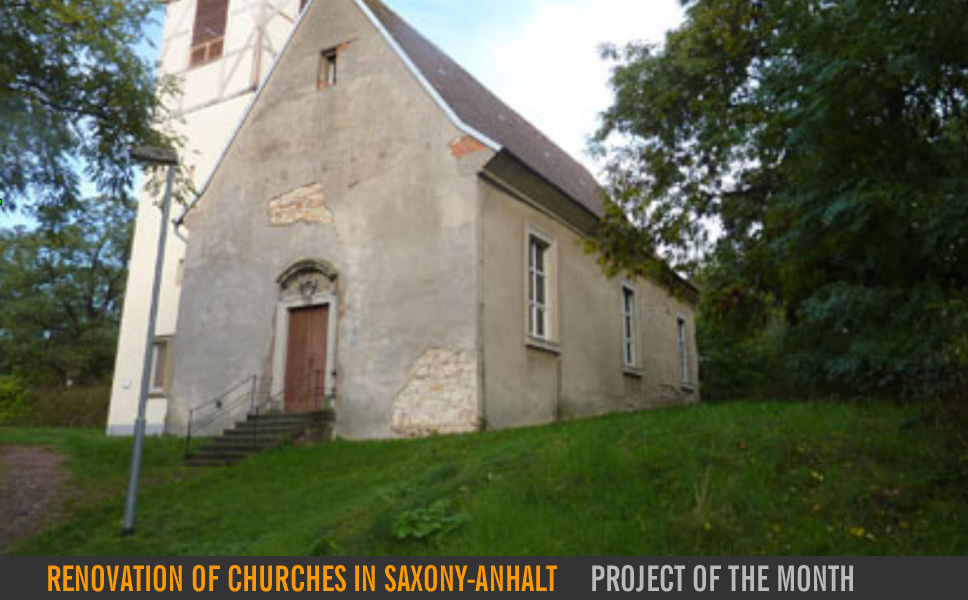
| |
epasit specialist building materials in practice
Architectural conservation: double renovation of churches in Saxony-Anhalt

Ammerbuch, date. One example for top-class architectural conservation is the double renovation of the Protestant churches in the neighbouring municipalities of Menz and Biederitz near Magdeburg (Saxony-Anhalt). Moisture had heavily damaged the external rendering of both churches as the years went by. The masons rehabilitated these churches with epasit specialist building materials from 2014 to 2015.
Masonry under the microscope

In the epasit laboratory in Ammerbuch, specimens of the historical church plaster were checked for their individual components and mineral composition. The architect in charge, Matthias Rau (Steinblock-Architekten, Magdeburg), and epasit construction engineer Matthias Jacob determined the sub-surface humidity and the surface dampness of the undermined external rendering on site. On this basis, the team created a rehabilitation proposal and got busy reproducing the historical lime mortar plaster.
.
Removal and renewal

Steinservice GmbH from Magdeburg carried out the plastering of both churches. Firstly, the employees removed the old plaster, revealing the natural stone masonry. Undermined joints were cleared out, cleaned and filled with the flexible joint grout epasit fmx. They treated tension and settlement cracks in the masonry with epasit ipu/2k, a solvent-free polyurethane resin for elastic crack injection. The adjacent ground was dug away up to 30 cm below the foundation. The workers mechanically cleaned the surface, and the joints were renewed as described above.
New plaster according to a traditional recipe

The employees primed the entire surface of the external walls with the epasit ab desiccation barrier. Then, they applied the epasit hb spray plaster primer until semiopaque to improve plaster adhesion. They moulded the base with epasit dp sperr up to 50 cm above the ground. The external rendering developed in the epasit laboratory according to a traditional recipe was applied in several layers of 20 mm each. The rehabilitation with the historical external rendering, which was successfully completed in 2015, equally delights viewers and curators of monuments
History of the St. Paulus church in Menz

The Protestant church of the Menz municipality is dedicated to the Apostle Paul. Originally, it was built on a sand dune above the location in 1525. In 1730, the municipality rebuilt and expanded the building. A new main entrance was created in the west portal and window openings in the baroque style and a flat ceiling in the church's interior were added. At the end of the Second World War the building was destroyed down to the foundation walls. The municipality rebuilt its church again from 1954 to 1959. The coping was topped off with a ring beam of reinforced concrete. Today, this ring beam is seen as problematic as regards the junction between the materials and their expansion properties, which must have been considered particularly during rehabilitation.
Biederitz village church: History

""The Biederitz Protestant church is of even higher value as a monument than its sister church in Menz", explains architect Matthias Rau, who managed the rehabilitation in 2014/2015. The original late Romanesque church, built in the 13th century, was destroyed in the Thirty Years' War. The new single-nave construction was only created in 1730. The constructors used undressed stone foundations for the western tower. The bell storey is half-timbered and topped by a transverse hip roof. The interior furnishings in the baroque style date back to 1730. The church was already renovated in 1989 and the tower in 2008. The main building was thoroughly rehabilitated in 2014/15.
New solutions for architectural conservation

High-quality listed structures, more than any other, require thermally insulating building materials in the interior which are at the same time surface-active and thus moisture regulating. These include both public institutions and a lot of residential buildings. In March 2016, epasit brought two new compact interior insulating boards of a purely mineral/eco-friendly composition onto the market. Now, it is also possible to meet the EnEV standard for listed buildings with a thermal conductivity value of ?=0.042W/mK for "epalith dp²" and ?=0.032W/mK for "epalith tp³".
epasit: expertise in building materials

Since 1957, epasit GmbH has been developing and producing special building materials for rehabilitation, renovation and modernization. The product range comprises, among other things, the waterproofing of buildings, the rehabilitation of monuments and old buildings and the rehabilitation of damage caused by mould and moisture. Drinking water tanks or swimming pools, too, are rehabilitated with epasit products. The family company has built a reputation as a think tank with sought-after inventions for building protection and building rehabilitation. In addition to its standard products, which have been tested time and again, epasit develops individual solutions for its customers.
Press contact:

epasit GmbH Spezialbaustoffe
Peggy Wandel
Sandweg 12 - 14, D-72119 Ammerbuch-Altingen, Germany
Tel (+49) 0 7032 2015-0, Fax (+49) 0 7032 2015-21
e-Mail: presse@epasit.de
|
|
|
|



